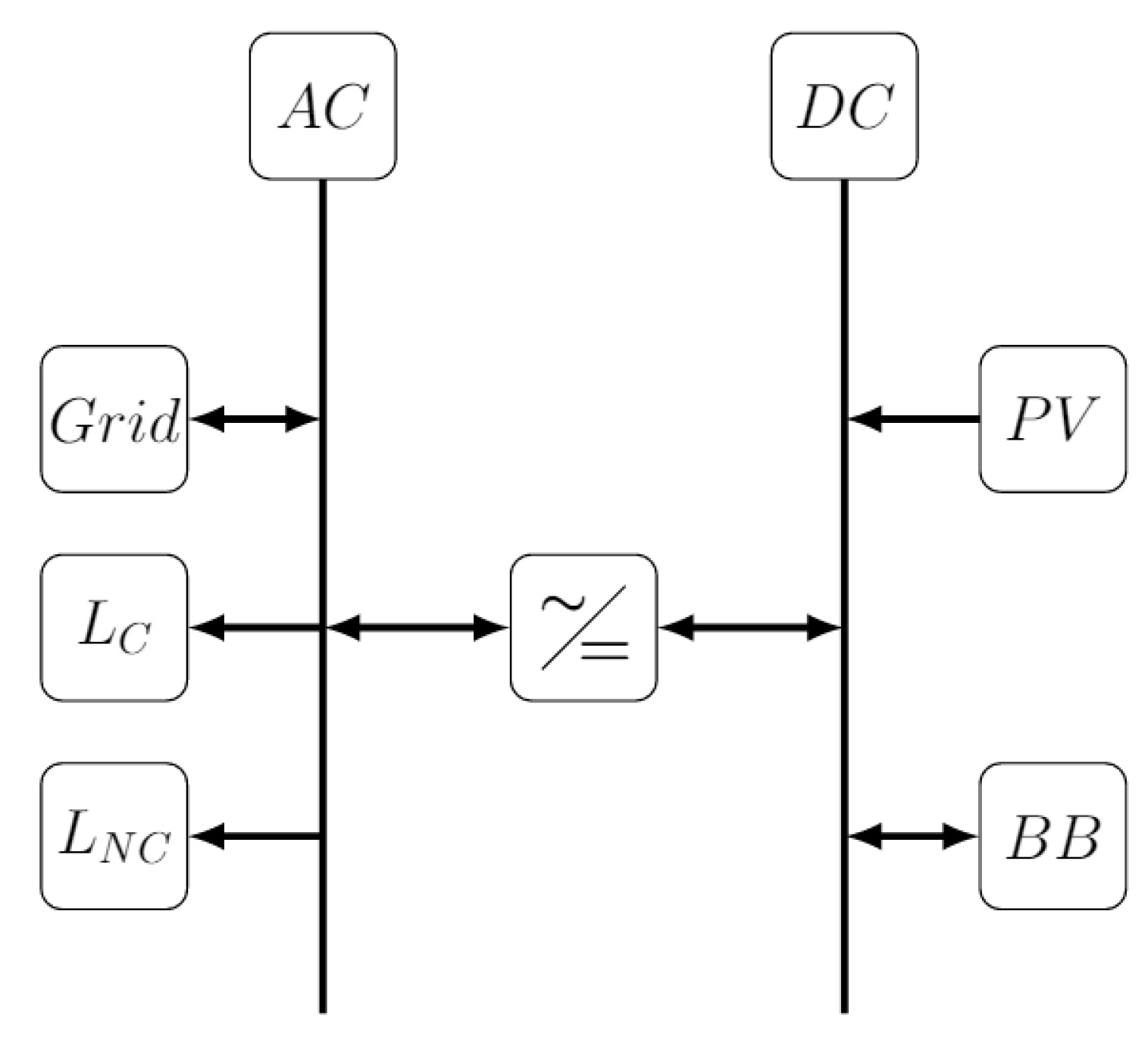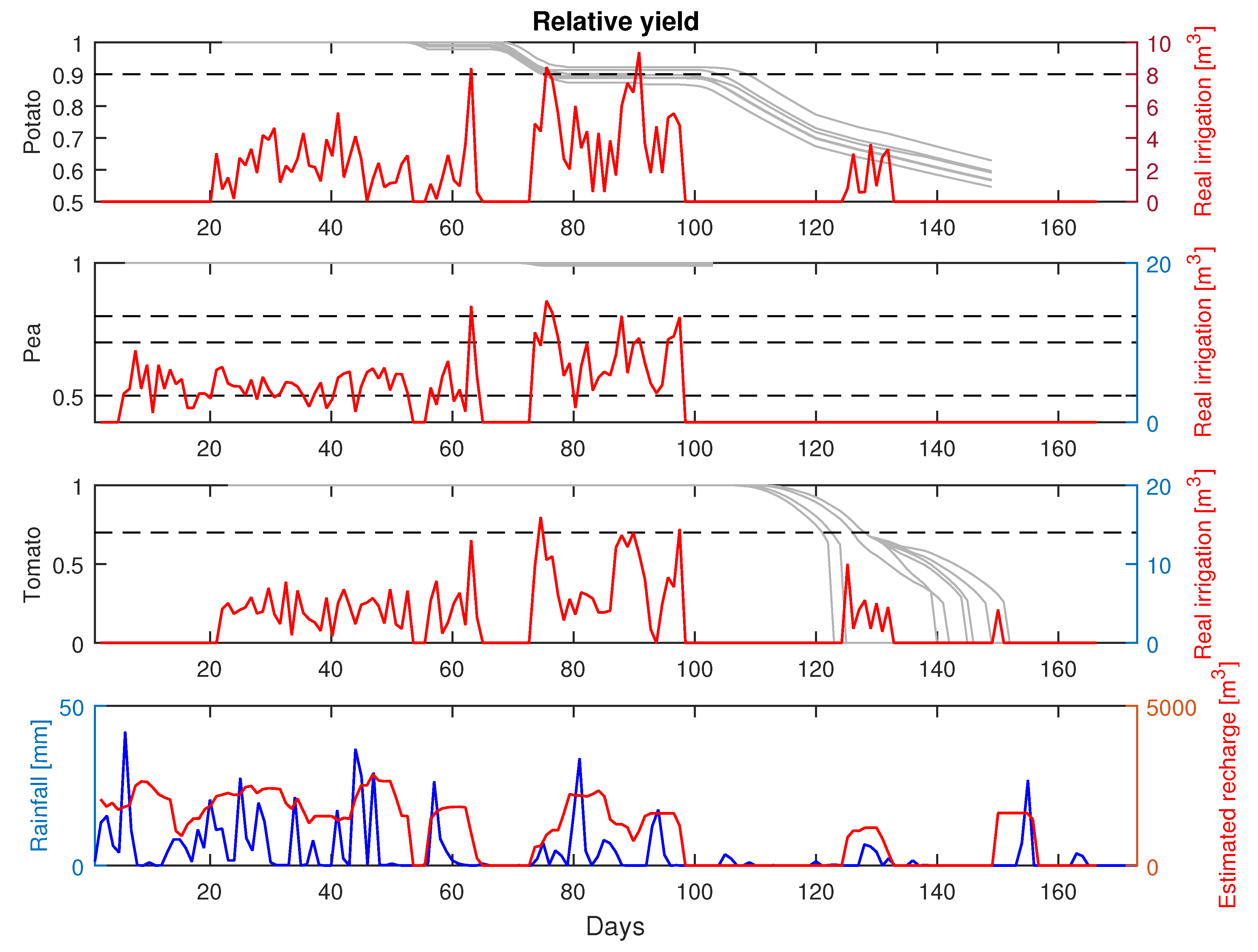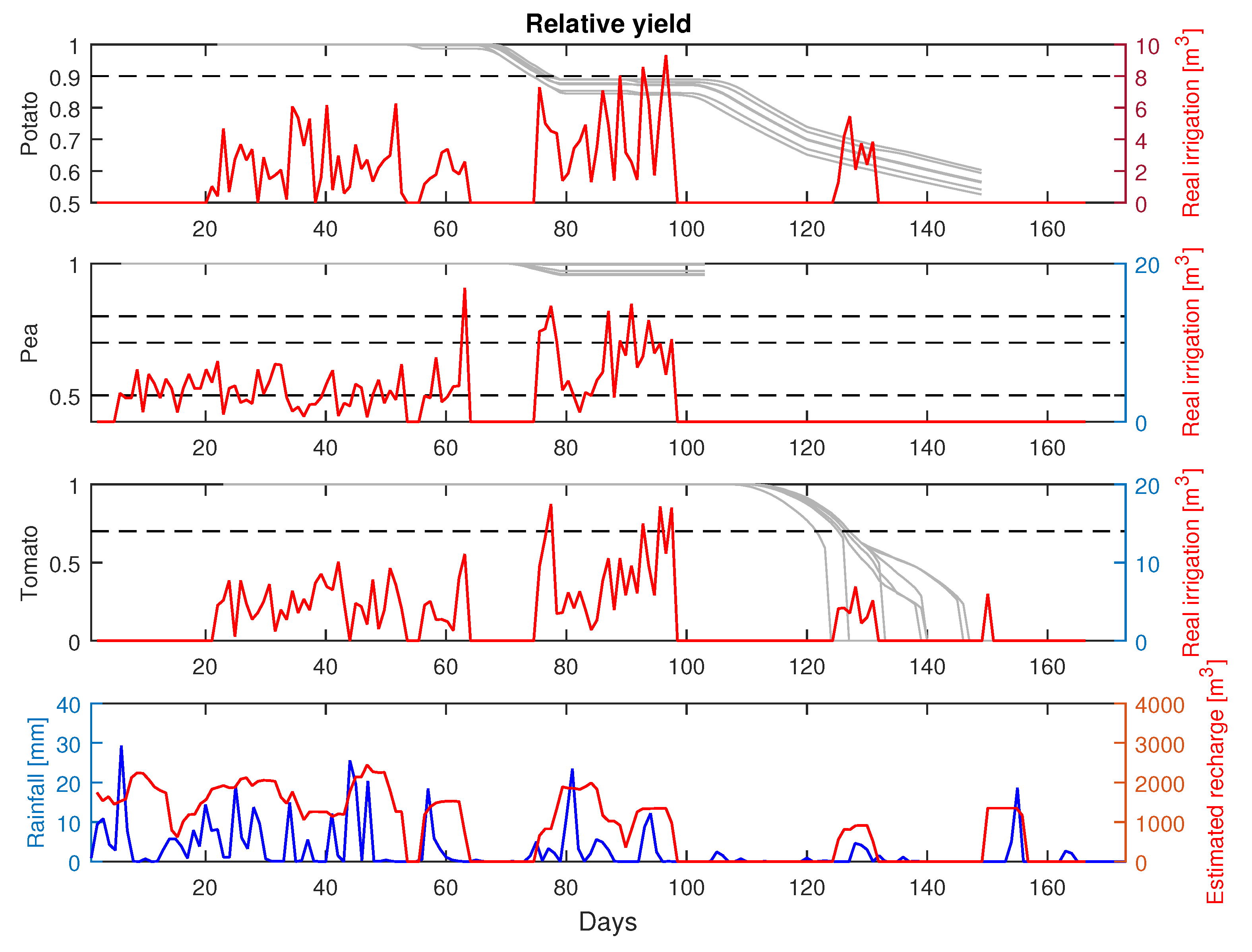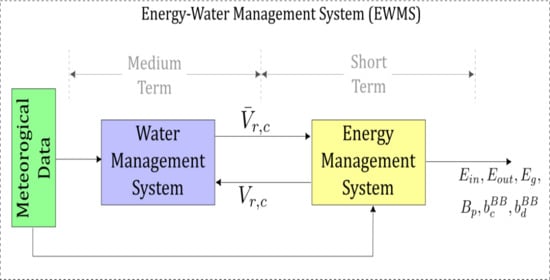Energy–Water Management System Based on Predictive Control Applied to the Water–Food–Energy Nexus in Rural Communities
Abstract
:1. Introduction
- A novel energy–water management system (EWMS) is proposed based on the joint optimization of water and energy resources using a model predictive control (MPC) strategy to manage the medium-term water requirements for irrigation and short-term energy requirements for water resource sustainability.
- A water management system (WMS) based on the MPC technique is proposed to minimize energy costs, including the expected benefits from crops and the availability of energy sources.
- An electricity management system (EMS) based on the MPC technique is established to include water availability and water use demand.
- The proposed EWMS is validated using real data from a rural community in southern Chile, demonstrating successful performance in terms of determining and meeting water and energy requirements under constraints relative to aquifer sustainability.
2. Background
2.1. Aquifer and Well Dynamics
2.2. Irrigation Demand
2.3. Principles of Model Predictive Control
3. Proposed Energy–Water Management System
3.1. Integrated EWMS
3.2. Energy Management System
3.3. Water Management System
4. Case Study
- Photovoltaic Power Plant, 90 kWp.
- Lead-acid Battery Bank, 43.2 kWh.
- 0.25 kW and 1.1 m/h centrifugal pumps at a hydraulic height of 14 m. One pump is assumed per farmer.
5. Results
6. Conclusions
Author Contributions
Funding
Conflicts of Interest
Abbreviations
| WMS | Water Management System |
| EMS | Energy Management System |
| EWMS | Energy–Water Management System |
| MPC | Model Predictive Control |
| HS | Hydrological System |
| DGA | General Water Directorate |
| TAW | Total Available Water |
| ARIMA | Auto-Regressive Integrated Moving Average |
References
- United Nations. World Population Prospects 2019: Wallchart; United Nations: New York, NY, USA, 2019; p. 2.
- Ferroukhi, R.; Nagpal, D.; Lopez-Peña, A.; Hodges, T.; Mohtar, R.H.; Daher, B.; Mohtar, S.; Keulertz, M. Renewable Energy in the Water, Energy and Food Nexus; International Renewable Energy Agency: Abu Dhabi, United Arab Emirates, 2015; pp. 1–125. [Google Scholar]
- Zhang, J.; Campana, P.E.; Yao, T.; Zhang, Y.; Lundblad, A.; Melton, F.; Yan, J. The water-food-energy nexus optimization approach to combat agricultural drought: A case study in the United States. Appl. Energy 2018, 227, 449–464. [Google Scholar] [CrossRef]
- Nhamo, L.; Ndlela, B.; Nhemachena, C.; Mabhaudhi, T.; Mpandeli, S.; Matchaya, G. The water-energy-food nexus: Climate risks and opportunities in Southern Africa. Water 2018, 10, 567. [Google Scholar] [CrossRef] [Green Version]
- Liu, Z.; Yang, J.; Jiang, W.; Wei, C.; Zhang, P.; Xu, J. Research on optimized energy scheduling of rural microgrid. Appl. Sci. 2019, 9, 4641. [Google Scholar] [CrossRef] [Green Version]
- Whitney, E.; Schnabel, W.E.; Aggarwal, S.; Huang, D.; Wies, R.W.; Karenzi, J.; Huntington, H.P.; Schmidt, J.I.; Dotson, A.D. MicroFEWs: A Food-Energy-Water Systems Approach to Renewable Energy Decisions in Islanded Microgrid Communities in Rural Alaska. Environ. Eng. Sci. 2019, 36, 843–849. [Google Scholar] [CrossRef] [Green Version]
- Alzola, J.A.; Camblong, H.; Niang, T. Promotion of Microgrids and Renewable Energy Sources for Electrification in Developing Countries; Technical Report; European Commission: Brussels, Belgium, 2008. [Google Scholar]
- Fornarelli, R.; Anda, M.; Louise, D.; Parisa, B. Conceptual model of energy and water micro-grid solutions with consumer engagement: An Australian case study. In Proceedings of the 10th International Conference on Water Sensitive Urban Design: Creating Water Sensitive Communities (WSUD 2018 & Hydropolis 2018), Perth, Australia, 13–15 February 2018; pp. 159–169. [Google Scholar]
- Zhang, X.; Sharma, R.; He, Y. Optimal energy management of a rural microgrid system using multi-objective optimization. In Proceedings of the 2012 IEEE PES Innovative Smart Grid Technologies (ISGT), Washington, DC, USA, 16–20 January 2012; IEEE: New York, NY, USA, 2012; pp. 1–8. [Google Scholar] [CrossRef]
- Michalski, J. Microgrids for Micro-Communities: Reducing the Energy Burden in Rural Areas. Mich. Technol. Law Rev. 2019, 26, 145–174. [Google Scholar] [CrossRef]
- Karan, E.; Asadi, S.; Mohtar, R.; Baawain, M. Towards the optimization of sustainable food-energy-water systems: A stochastic approach. J. Clean. Prod. 2018, 171, 662–674. [Google Scholar] [CrossRef]
- Chen, C.; Zeng, X.; Yu, L.; Huang, G.; Li, Y. Planning energy-water nexus systems based on a dual risk aversion optimization method under multiple uncertainties. J. Clean. Prod. 2020, 255, 120100. [Google Scholar] [CrossRef]
- Nikam, N.G.; Regulwar, D.G. Optimal Operation of Multipurpose Reservoir for Irrigation Planning with Conjunctive Use of Surface and Groundwater. J. Water Resour. Prot. 2015, 7, 636–646. [Google Scholar] [CrossRef] [Green Version]
- Mérida, A.; Gallagher, J.; McNabola, A.; Camacho, E.; Montesinos, P.; Rodríguez, J.A. Comparing the environmental and economic impacts of on- or off-grid solar photovoltaics with traditional energy sources for rural irrigation systems. Renew. Energy 2019, 140, 895–904. [Google Scholar] [CrossRef]
- Powell, J.W.; Welsh, J.M.; Farquharson, R. Investment analysis of solar energy in a hybrid diesel irrigation pumping system in New South Wales, Australia. J. Clean. Prod. 2019, 224, 444–454. [Google Scholar] [CrossRef]
- Labadie, J.W. Optimal Operation of Multireservoir Systems: State-of-the-Art Review. J. Water Resour. Plan. Manag. 2004, 130, 93–111. [Google Scholar] [CrossRef]
- William, W.G.Y. Reservoir Management and Operations Models. Water Resour. Res. 1985, 21, 1797–1818. [Google Scholar] [CrossRef]
- Brdys, M.A.; Grochowski, M.; Giminski, T.; Konarczak, K.; Drewa, M. Hierarchical predictive control of integrated wastewater treatment systems. Control Eng. Pract. 2008, 16, 751–767. [Google Scholar] [CrossRef]
- Vedula, S.; Nagesh Kumar, D. An integrated model for optimal reservoir operation for irrigation of multiple crops. Water Resour. Res. 1996, 32, 1101–1108. [Google Scholar] [CrossRef]
- Reddy, M.J.; Kumar, D.N. Optimal reservoir operation for irrigation of multiple crops using elitist-mutated particle swarm optimization. Hydrol. Sci. J. 2007, 52, 686–701. [Google Scholar] [CrossRef]
- Cai, X.; McKinney, D.C.; Lasdon, L.S. Integrated hydrologic-agronomic-economic model for river basin management. J. Water Resour. Plan. Manag. 2003, 129, 4–17. [Google Scholar] [CrossRef] [Green Version]
- Georgiou, P.E.; Papamichail, D.M. Optimization model of an irrigation reservoir for water allocation and crop planning under various weather conditions. Irrig. Sci. 2008, 26, 487–504. [Google Scholar] [CrossRef]
- Georgiou, P.E.; Papamichail, D.M.; Vougioukas, S.G. Optimal irrigation reservoir operation and simultaneous multi-crop cultivation area selection using simulated annealing. Irrig. Drain. 2006, 55, 129–144. [Google Scholar] [CrossRef]
- Famiglietti, J.S. The global groundwater crisis. Nat. Clim. Chang. 2014, 4, 945–948. [Google Scholar] [CrossRef]
- Vahid Pakdel, M.J.; Sohrabi, F.; Mohammadi-Ivatloo, B. Multi-objective optimization of energy and water management in networked hubs considering transactive energy. J. Clean. Prod. 2020, 266, 121936. [Google Scholar] [CrossRef]
- Garreaud, R.D.; Boisier, J.P.; Rondanelli, R.; Montecinos, A.; Sepúlveda, H.H.; Veloso-Aguila, D. The Central Chile Mega Drought (2010–2018): A climate dynamics perspective. Int. J. Climatol. 2020, 40, 421–439. [Google Scholar] [CrossRef]
- Información para el Desarrollo Productivo Ltda. (INFODEP). Elaboración de una Base Digital del Clima Comunal de Chile: Línea Base (1980–2010) y Proyección al Año 2050; Technical Report; Ministerio del Medio Ambiente: Santiago, Chile, 2016. [Google Scholar]
- Chai, J.; Shi, H.; Lu, Q.; Hu, Y. Quantifying and predicting the Water-Energy-Food-Economy-Society-Environment Nexus based on Bayesian networks—A case study of China. J. Clean. Prod. 2020, 256, 1–11. [Google Scholar] [CrossRef]
- Theis, C. The relation between the lowering of the Piezometric surface and the rate and duration of discharge of a well using ground-water storage. Eos Trans. Am. Geophys. Union 1935, 16, 519–524. [Google Scholar] [CrossRef]
- Raes, D.; Geerts, S.; Kipkorir, E.; Wellens, J.; Sahli, A. Simulation of yield decline as a result of water stress with a robust soil water balance model. Agric. Water Manag. 2006, 81, 335–357. [Google Scholar] [CrossRef]
- Jensen, M.E. Water consumption by agricultural plants. In Plant Water Consumption and Response. Water Deficits and Plant Growth; Kozlowski, T.T., Ed.; USDA: New York, NY, USA, 1968; Volume II, pp. 1–22. [Google Scholar]
- Monteith, J. Symposia of the Society for Experimental Biology. Yale J. Biol. Med. 1965, 25, 205–234. [Google Scholar]
- Doorenbos, J.; Bentvelsen, C.L.M.; Kassam, A.H.; Branscheid, V.; Bentvelsen, C.I.M. Yield Response to Water; FAO Irrigation and Drainage Paper; Food and Agriculture Organization of the United Nations: Rome, Italy, 1979; p. 193. [Google Scholar]
- Allen, R.; Pereira, L.; Raes, D.; Smith, M. Crop Evapotranspiration—Guidelines for Computing Crop Water Requirements; Technical Report; Food and Agriculture Organization of the United Nations: Rome, Italy, 1998. [Google Scholar]
- Camacho, E.F.; Bordons, C. Model Predictive Controllers, 2nd ed.; Springer: London, UK, 2007; p. 405. [Google Scholar] [CrossRef]
- Löfberg, J. YALMIP: A Toolbox for Modeling and Optimization in MATLAB. In Proceedings of the CACSD Conference, New Orleans, LA, USA, 2–4 September 2004. [Google Scholar]
- Smith, M.; Steduto, P. Yield Response to Water: The Original FAO Water; Technical Report; Food and Agriculture Organization of the United Nations: Rome, Italy, 2012. [Google Scholar]
- Ministerio de Desarrollo Social y Familia. CASEN 2017. Available online: http://datos.energiaabierta.cl/dataviews/256138/casen-2017-acceso-a-electricidad/ (accessed on 9 January 2020).
- Ministerio de Energía. Ruta de la Luz. 2019. Available online: https://www.energia.gob.cl/iniciativas/ruta-de-la-luz (accessed on 9 January 2020).
- Ciren, SitRural, Ministerio de Agricultura. Recursos Naturales, Comuna de Carahue; Technical Report; Ministerio de Agricultura: Santiago, Chile, 2018. [Google Scholar]
- Acevedo, P. Situación del Agua en la Araucanía. 2020. Available online: https://observatorio.cl/situacion-del-agua-en-la-araucania/ (accessed on 9 January 2020).
- Comisión Nacional de Energía. Electricidad—Energía Abierta. 2020. Available online: http://energiaabierta.cl/estadisticas/electricidad/?lang=en (accessed on 9 January 2020).
- Vargas, C.; Morales, R.; Sáez, D.; Hernández, R.; Muñoz, C.; Huircán, J.; Espina, E.; Alarcón, C.; Caquilpan, V.; Paine, N.; et al. Microgrid/Smart-Farm System: Case study applied to Indigenous Mapuche Communities. In Proceedings of the AACC’18 (The Second International Conference of ICT for Adapting Agriculture to Climate Change), Cali, Colombia, 21–23 November 2018; pp. 1–22. [Google Scholar]









| Parameter | Potato | Pea | Tomato |
|---|---|---|---|
| Crop start | 31 July | 15 July | 1 August |
| Sale price [CLP/kg] | 280 | 560 | 220 |
| [kg/ha] | 31.760 | 1.280 | 86.910 |
| Max height [m] | 0.6 | 0.5 | 0.9 |
| Root depth [m] | 0.4 | 0.8 | 0.6 |
| Stage duration [d] | [25,30,45,30] | [20,30,35,15] | [30,40,40,25] |
| [0.4,0.33,0.46,0.2] | [1,1,1,1] | [1,1,1,1] | |
| [0.4,1.15,0.75] | [0.5,1.15,1.1] | [0.6,1.15,0.8] | |
| 0.35 | 0.35 | 0.4 | |
| 70 | 63 | 65 |
| Potato | Pea | Tomato | ||||
|---|---|---|---|---|---|---|
| Area [m] | Area [m] | Area [m] | ||||
| 500 | 0.9 | 250 | 0.8 | - | - | |
| 1.000 | 0.9 | 500 | 0.8 | 250 | 0.7 | |
| - | - | 750 | 0.8 | 1.000 | 0.7 | |
| - | - | - | - | 125 | 0.7 | |
| 250 | 0.9 | 125 | 0.5 | 125 | 0.7 | |
| 250 | 0.9 | 250 | 0.8 | - | - | |
| 250 | 0.9 | 500 | 0,8 | 125 | 0.7 | |
| - | - | 750 | 0.8 | 500 | 0.7 | |
| - | - | - | - | 125 | 0,7 | |
| 250 | 0.9 | 500 | 0.7 | 125 | 0.7 | |
| Scenario | Costs [] | Profit [] | Water Consumption [m] |
|---|---|---|---|
| : Normal rainfall | 120,343 | 1514 | 1159.2 |
| : Decreased rainfall of 15% | 127,135 | 1511 | 1090.2 |
| : Decreased rainfall of 30% | 140,840 | 1467 | 1105.3 |
Publisher’s Note: MDPI stays neutral with regard to jurisdictional claims in published maps and institutional affiliations. |
© 2020 by the authors. Licensee MDPI, Basel, Switzerland. This article is an open access article distributed under the terms and conditions of the Creative Commons Attribution (CC BY) license (http://creativecommons.org/licenses/by/4.0/).
Share and Cite
Roje, T.; Sáez, D.; Muñoz, C.; Daniele, L. Energy–Water Management System Based on Predictive Control Applied to the Water–Food–Energy Nexus in Rural Communities. Appl. Sci. 2020, 10, 7723. https://doi.org/10.3390/app10217723
Roje T, Sáez D, Muñoz C, Daniele L. Energy–Water Management System Based on Predictive Control Applied to the Water–Food–Energy Nexus in Rural Communities. Applied Sciences. 2020; 10(21):7723. https://doi.org/10.3390/app10217723
Chicago/Turabian StyleRoje, Tomislav, Doris Sáez, Carlos Muñoz, and Linda Daniele. 2020. "Energy–Water Management System Based on Predictive Control Applied to the Water–Food–Energy Nexus in Rural Communities" Applied Sciences 10, no. 21: 7723. https://doi.org/10.3390/app10217723
APA StyleRoje, T., Sáez, D., Muñoz, C., & Daniele, L. (2020). Energy–Water Management System Based on Predictive Control Applied to the Water–Food–Energy Nexus in Rural Communities. Applied Sciences, 10(21), 7723. https://doi.org/10.3390/app10217723








